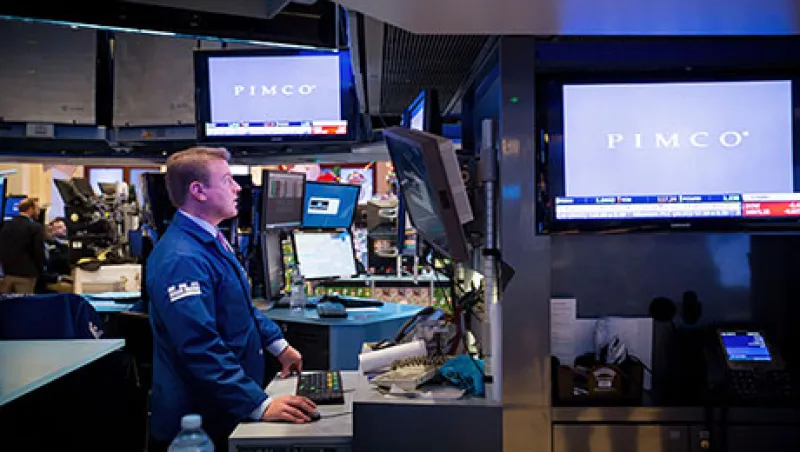Pacific Investment Management Co.’s lineup of 16 smart-beta funds, co-branded with Rob Arnott’s Research Affiliates, is bleeding assets, even as the category as a whole remains one of the fastest-growing segments of the asset management industry.
From January through the end of November 2016, the PIMCO RAE Funds posted net outflows of $3.5 billion, according to data gathered by Morningstar. In 2015, the fund lineup suffered $8.1 billion in net outflows. The PIMCO smart beta funds brought in a net $1.6 billion in assets in 2014. Outflows had already started, however, with the funds losing $2.4 billion in assets in December of that year.
The funds managed $14.2 billion in assets as of January 6, compared with $30 billion at the end of the third quarter of 2014. PIMCO could not provide additional information before publication.
The PIMCO/Research Affiliates venture got a big boost in January 2015. At the time, PIMCO CEO Douglas Hodge touted the expansion of its then 10-year-old relationship with Arnott as a way to satisfy investors’ appetite for passive strategies, without the inefficiencies of traditional index funds. The firm, which has made attempts to get into the equities business since 2009, was also betting that smart beta could be a unique strategy to diversify away from bond funds. PIMCO launched seven equity funds that focused on investments in small and large companies in the U.S. and international markets.
PIMCO also added the Research Affiliates’ brand — RAE — to the fund lineup, hoping to leverage Arnott’s high-profile reputation and pioneering role in smart beta when he developed fundamental indices. Arnott’s idea was to determine the relative proportion of companies within an index using fundamental factors. The innovation was a big departure from the methods behind market capitalization-weighted indexes, benchmarks used by the Vanguard Group, the world’s largest passive manager. Smart-beta funds, which are often called factor-based or strategic-beta funds, are generally based on a set of rules that give investors exposure to specific stock and bond characteristics, such as value or momentum.
Performance is often the biggest factor driving investor flows into and out of funds. The largest fund in PIMCO’s smart-beta family, the $1.8 billion PIMCO RAE Fundamental PLUS Fund (PXTIX), performed poorly in 2015, losing 6.59 percent and ranking in the 93rd percentile of its large-value peers. In 2014, the fund — which peaked at $4.3 billion in assets at the end of August that year, according to Bloomberg — outperformed peers by 1.98 percent, but ranked in the 42nd percentile.
That was in stark contrast to the fund’s earlier years. In 2009, 2010 and 2012, it ranked in the 1st percentile, and it ranked in the 5th percentile in 2011.
The fund rebounded sharply in 2016, returning 19.48 percent and outperforming peers by 4.67 percent. Even so, the fund had net outflows every month last year. In November, however, the fund’s net outflows seemed to be stabilizing. That month, they dropped to $9 million, compared with $136 million in January and $151 million in February 2015.
Other PIMCO RAE funds have produced mixed results. The PIMCO RAE Fundamental Advantage PLUS Fund, a market-neutral, strategic-beta strategy, ranks in the 28th percentile in its category for the five-year period ending January 6, outperforming peers by 1.15 percent, according to Morningstar. For the one-year period ending on the same date, the fund lands in the 13th percentile, and in the 68th percentile over three years. The fund had net outflows last year through November of $543 million, after losing $1.4 billion in 2015. The fund, which now has $453 million, peaked at $5.9 billion in assets in May 2011.
Other PIMCO RAE funds have good track records over longer periods, but have been hit hard in certain years. The PIMCO RAE Fundamental PLUS EMG Fund, which focuses on the emerging markets, is one example. Over five years, the $1.3 billion fund is in the 19th percentile of its category, in the 5th percentile over three years, and in the first percentile over one year. But in 2013, it fell into the 89th percentile, losing 6.38 percent more than its category average. Performance improved significantly the following year, but in 2015, it landed in the bottom one percent of its peers. In 2014, the fund suffered $5 billion in net outflows; $778 million followed in 2015 and $953 million through the end of November 2016.
Flows out of PIMCO’s smart-beta funds are also tied to two other funds managed by Research Affiliates, the $18.4 billion PIMCO All Asset Fund and the $7.8 billion PIMCO All Asset All Authority Fund. In November, Christopher Brightman, CIO of Research Affiliates, began managing the funds along with Arnott. Funds in PIMCO’s smart-beta lineup are among the underlying funds used by Arnott and Brightman to express their investment views within All Asset and All Asset All Authority, both of which are tactical allocation funds.
Investors have been pulling money from those funds, in turn forcing PIMCO to sell some of the underlying smart-beta portfolios. Though performance has improved substantially in 2016, both tactical allocation funds suffered downturns in 2013, 2014 and 2015. The All Asset Fund hit a high of $35 billion in 2013, while All Asset All Authority hit a high of $36 billion that year. According to Bloomberg, All Asset and All Authority are the biggest institutional holders of some of the smart beta funds.







